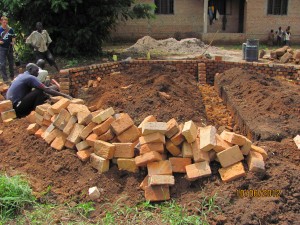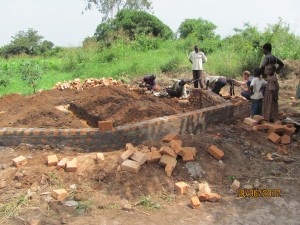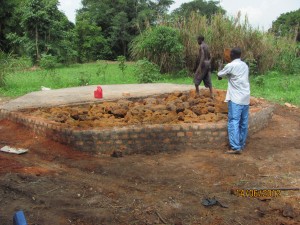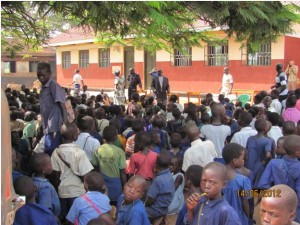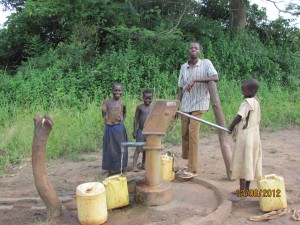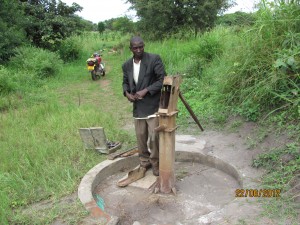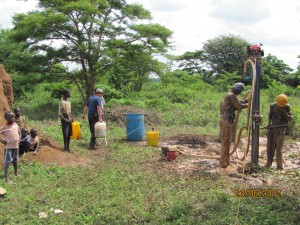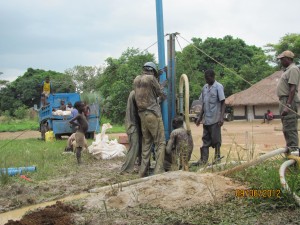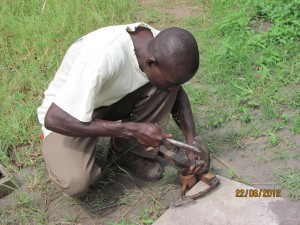Report of Field Activities in Uganda
for Northern Uganda Development Foundation
June 1st to July 3rd, 2012
Submitted by Ted Renquist
Please accept the following report of the field activities of the author for the period June 1st to July 3rd, 2012, for the Northern Uganda Development Foundation. This report is divided into two sections. The first is a chronological outline of the author’s activities in the field for the period noted above. The second section is a more detailed description of the activities in a thematic format. Each theme includes observations, and a summary of discussions with participants in the NUDF sponsored activities and/or NUDF staff working in that activity. At the end of each thematic section are recommendations to the NUDF directors in Canada regarding the continued support of NUDF for a given project. These were vetted through NUDF staff in Uganda including the field manager Mr. Geoffrey Odongo. The chronology of the author’s activities in the field is listed below.
June 1– arrival at Entebbe; met by Mr. Odongo and taken to the hotel in Kampala
June 2– exchanged money, purchased cell phone which proved to be a necessity; registered cell phone number
June 3– sightseeing in Kampala
June 4– sightseeing in Kampala
June 5– visited the national museum
June 6– Mr. Johnson arrives, shopped for NUDF fund raising items
June 7– left for Kamdini; registered at Pope John Hospital at Atapara
June 8– visited Canada House; viewed construction of both house and guest house; filmed interview at Canada House with Mr.
Johnson
June 9– Observed drilling operation of new well; filmed interview with village people and committee members regarding how the
well will improve their lives
June 10– author began inspection of existing NUDF wells with Robert, a NUDF staff member
June 11– continued inspection of wells; Mr Odongo returned to Kampala to pick up UNBC student arriving at Entebbe
June 12– continued inspection of wells
June 13– continued inspection of wells; motorcycle breaks down; all the members of the team arrive at Atapara
June 14– team members attended ceremony at Kamdini Primary School; medical supplies and school equipment given to the school; team tours school; filmed promotional segment for NUDF documentary
June 15– author sick; other team members visited Murchison Falls National Park
June 16– visited demonstration farm in the morning; filmed promotional segment for NUDF documentary; all but the author returned to Kampala
June 17– continued to inspect wells
June 18 to 20– met with local committee in Bora Bora
June 19– met Lawrence drilling technician to determine location of well in Bora Bora
June 21– returned from Bora Bora to Atapara
June 22– accompanied Robert to repair wells
June 23– returned to Bora Bora to drill well
June 24– met with committee members in Bora Bora discussing well completion
June 25– returned to Kamdini; prepared mini budget in consultation with field manager; reviewed recommendations with field manager
June 26– travelled to Kampala by bus
June 27– emailed mini budget; began writing draft report
June 28 to 30– report writing; shopping for NUDF items for fund raising
July 1, 2– report writing, shopping for NUDF items for fund raising
July 4– departure from Entebbe to Canada via London
Canada House and Accommodation
The second part of this 2012 trip report will take a thematic approach so that the recommendations included in this section have some background and meaning.
The first issue this report will tackle is the problem of accommodations to carry out meaningful field work. The team stayed at the Pope John Hospital located in the village of Atapara about ten to fifteen kilometers from Kamdini. The team was under the impression accommodation would include room and board; i.e. that a cook would be provided to prepare a breakfast and dinner for about $13.00 per day. In fact this was not the case. The team members were provided a sleeping room with bathroom facilities and showers down the hall, but no cooking facilities or a cook. The bathroom facilities were of dubious sanitary standards. The toilet floors had dead insects and mouse droppings. The floor had a continuous puddle of water that was seeping up through the cement and tile floor. After some negotiations with the administrator and only when pressed did they set up a cooking room which included a two burner gas stove and some pots and dishes. Water of dubious quality was provided; we did not trust the quality because we observed several swimming creatures including what looked like a leech in the water. The team members were unprepared for this and had not purchased the appropriate food and supplies required for this type of accommodation. The situation was made worse by the fact there was no food to be purchased in either Atapara or Kamdini. Mr. Johnson`s fiancée who volunteered to cook took sick and could not cook on several evenings. The team resorted to take out in Kamdini, of porsho, beans, chicken or barbecued goat meat from the street after the field work. Refrigeration was restricted because it was shared with the nuns at the convent. Any time we wanted to get something from the refrigerator we had to find a nun to allow us access to the refrigerator. Since refrigeration was restricted at Atapara the take out was often on the verge of spoiling by dinner time. The reason for the detailed account of the living conditions at Atapara is to give background to the following recommendation.
Recommendation: Canada House and at least one guest house must be finished as soon as possible so that field workers can be assured of access to reasonable food and accommodation.
The Demonstration Farm
One of the greatest changes the author noted between this 2012 trip and the one five years ago is the spectacular increase in tilled land. Five years ago most of the farmland had returned to scrub bush with only the most meagre of gardens for sustenance. Today, the land has been cleared again, gardens are evident everywhere and oxen teams not seen on the last visit, are frequently observed plowing fields.
Despite the increase of tilled land, the vagaries of the market have not been kind to the average farmer. High prices were promised to the farmers if they grew cotton or sunflowers, but when these crops were harvested the value of these crops had severely declined. Farmers now are growing a tremendous amount of corn or maize as a cash crop. When asked why they were growing so much maize many farmers replied that if the price declined at least they could eat the maize.
The demonstration farm operated by Anna and the women’s group has made a real and significant difference to the agricultural practices of the local farmers and to the diet of the people. Cabbage and tomatoes for instance, which the demonstration farm grows, were not seen in the markets with any regularity five years ago, are now readily available. The demonstration farm has promoted mono culture of crops instead of the traditional mixed crop garden, to increase crop yields. It should be noted that the author saw several farms in the area carrying out this practice. Rice, a luxury item five years ago is now a regular crop on the under cultivation on the demonstration farm and is also being cultivated on surrounding farms in the area.
How then can the demonstration farm continue to help the local farmers to increase the family income and protect it through diversification from the boom and bust of market prices for cash crops? One way to increase family income is to increase the amount of land under cultivation.
Recommendation: NUDF should purchase three more plows so that all of the available oxen teams on the farm have a plow. At this time there are eight teams of oxen, but only five plows.
To effectively diversify farm and family income the demonstration farm should find and
actively promote alternate forms of income. There is a construction boom in Uganda at this time, but a shortage of lumber and timbers. Many farmers have begun planting trees for lumber on land unsuitable for tilling for a future income. Species that grow quickly, like the Brazilian pine, can be harvested for timbers in five to seven years and for lumber within fifteen years. There are no seedling nurseries in the immediate area. A nursery at the demonstration farm should meet with considerable success. Some farmers were accessing seedlings from Kampala or Lira for as much as five hundred shillings per seedling because there is a shortage of seedlings.
Recommendation: The demonstration farm should develop a business plan to establish a seedling nursery to sell seedlings to local farms to help diversify farm income.
In conjunction with small woodlots is the possibility of bee keeping. Honey production is very lucrative. African honey especially organic honey is fetching record prices. The author observed one woodlot of perhaps half a hectare that contained eight hives and according to the farmer paying the boarding school fees for three of his children.
Recommendation: The demonstration farm should investigate the possibility of establishing a demonstration bee keeping operation for the surrounding community of farmers.
Another potential source of revenue to diversify farm income could be the raising of pigs. This would not be the type of rearing often seen today where the pig is tethered to the mango tree and feeds on the fruit that falls to the ground. The suggestion of this report is to construct proper pig enclosures and sties of brick and mortar with concrete floors. Pork production would be an ideal commodity. They mature quickly, breed easily and have multiple litters through the year. Swine in many agricultural areas are a natural by product of the major agricultural activity as for instance grain or dairy production. Northern Uganda should have a natural advantage given the amount of maize grown and the surplus fruit available. Another advantage is that local expertise is already in the region. The profitability of raising pigs was confirmed in three separate casual conversations; two people that were raising swine already and the third was a buyer who travelled as far as Gulu to purchase swine for the Kampala market.
Recommendation: The demonstration farm should develop a business plan to establish a demonstration piggery to help diversify local farm income.
The location of the demonstration farm adjacent to the Tuchi River begs the question, is fish farming possible? The author had one conversation with a land owner who was establishing a fish farm on her land adjacent to the Nile River. Fish farming is more capital intensive than other activities, but might offer some labour opportunities for local farm families.
Recommendation: The demonstration farm should investigate the possibilities of fish farming to diversify farm and family income.
Finally, another farm activity of NUDF has been the purchase and distribution of goats to needy families in the area. However, it is impossible to determine what happens to the goats after some time. Have they been eaten, sold or bred to produce more goats, no one can answer for sure. The procedure for distribution now used does not promote further prosperity within the community.
Recommendation: NUDF purchase an animal tattoo machine. A goat given to a needy family will be tattooed and the requirement is that the family return one baby born from the original goat to NUDF for tattooing and transfer to another needy family.
Kamdini Primary School
At no other time during his stay in Uganda did the author see the crushing needs of the people, yet feel an enormous sense of pride for what they have accomplished with so little. At the time of our visit the school’s enrollment had reached 1720 students. The senior primary grades averaged seventy to eighty students per classroom and the lower grades had up to one hundred and twenty students per classroom. The staff and students are very proud of the small library they have established, the computer and the solar panel supplied by NUDF and the boarding option just implemented for both male and female senior students. The school’s growth plans posted on the walls of the Head Teacher’s office are very progressive and include housing for teachers and a reduction in class size to sixty. The gifts presented to the school during our visit including anti malarial drugs, anti bacterial creams, bandages and paper for the computer were greatly appreciated. This report however recommends a change in the type of support for the school.
Recommendation: Future support of the school should be diverted toward primary health and safety of students and staff.
The head teacher admitted that between twenty and twenty five percent of the students “absented themselves from school.” He believed the absenteeism was because many students chose to participate in the street economy selling goods to travellers passing through Kamdini. This may be true. Certainly, everyone in the family needs to help earn the family income in time of need. A more realistic answer is that the students are getting sick at home perhaps from bad water or sick at school from poor hygiene. Proof of this situation is that after the school visit four of the five visitors became sick with various ailments including diarrhea, flu symptoms and colds starting the day after the visit.
Primary health care must begin with the student’s toilets which need to be cleaned and sterilized every day. Both the male and female toilet floors were covered with feces to the doorway and had not been cleaned for some time. Wash stations to wash hands were not observed either near the toilets or the classrooms. Further NUDF support should be directed to the construction or purchase of wash stations and the students should be instructed in proper hand washing techniques which has proven to be the most effective way of preventing illness. If not already a practice, the staff should establish a morning check of the students’ health and sent home. Further, the school should eliminate the room next to the kitchen where the chickens are burrowing. Young children not toilet trained should be diapered. The author watched a young child relieve himself in the school courtyard. The mother, a teacher cleaned up the child and the ground, nevertheless an unsanitary condition was present.
The school’s boarding program should be curtailed or severely limited until better health and safety standards can be met. For example, about forty five boys are sleeping on mattresses on the floor on an old classroom with no light and poor ventilation. Space is at such a premium the mattresses are touching each other and the boys must walk across other mattresses to get to their own space. The girl’s dormitory is two rooms and they have more space, but the conditions are similar to the boy’s dormitory. Nowhere did the author observe buckets of water or sand in case of fire or procedures posted for the evacuation of the dormitories. The author could only reflect back to past health and safety reports of residential schools in Canada and the appalling rates of disease as a result of overcrowding in the dormitories. The sad death of five primary students at a boarding school in Masaka during our stay in Uganda adds to our concern. According to the media there were no fire extinguishers in the dormitories, the staff was not trained in evacuation procedures and most disconcerting many of the doors to the dormitory were locked.
Wells
The primary objective of the author in Uganda was to inspect the NUDF wells drilled to date. However, because of the short time span that Mr. Johnson had in northern Uganda, the priority became the development and filming of NUDF activities for a promotional video. With the time for inspection therefore limited, in response and with the approval of Mr. Odongo we decided to do a random survey of wells. Each day Robert, the motorcycle driver took us in a different direction and side of a highway and we inspected those wells in the area. The results of the inspection are on a spreadsheet attached to this report. The following is a summary of the information gathered from the inspection notes.
Wells inspected- 24 out of 42 wells drilled to date, or 57%
Wells working- 18 or 75%
Wells not working- 6 or 25%
Construction dates of wells not working, 2007- 2, 2008- 3, 2011- 1
Common problems- bearings worn out
– Pipes corroded and need replacement
– Basins need resurfacing
– No guard around pump handle which leads to misuse
With regards to the condition and upkeep of the existing wells it became apparent that after three years a well would probably need some major repairs. The replacement of the handle bearings and the galvanized draw pipes inside the well were the most common problems. Our survey also noted a breakdown in communication between the community and NUDF also occurred with the older wells. There are many reasons for this, but one common feature was that the original community leadership that got the well installed was not cohesive enough to last. As a result when repairs were need no one knew who to contact. Many communities did not follow through with a community use collection system for repairs; consequently there was no money for repairs.
Recommendation: NUDF field staff commits time and resources toward monitoring the condition of the existing wells and strengthening contacts with community leaders on a quarterly basis.
While in the field the author watched three wells being drilled. The drill technician, Lawrence, is to be commended for his abilities; he has a feel for the machinery so that the equipment is never pushed past its capabilities. After drilling the equipment is carefully cleaned lubricated and safely packed for transport. NUDF should make every effort to keep him on staff. The drilling operation is definitely a very dirty and dangerous job with the equipment in use and water spraying everywhere while the drill head is in operation. The only safety equipment in use was hard hats when the drill rig was in operation. NUDF needs to consider the health and safety of the drill crew.
Recommendation: NUDF equip the drilling team with proper safety equipment. This would include safety toed rubber boots, hard hats equipped with face shields and water proof suits to keep the workers dry.
The author also spent two days with Robert repairing wells. It was frustrating work because Robert does not have the proper tools to do a repair in a timely fashion. For example, at the first well to be repaired we spent two hours trying to punch out the hardened steel race of the broken bearing with a hammer and a piece of soft steel used for a punch. Robert has no ratchet set, wrench set, proper punches or chisels.
Recommendation: NUDF purchase the appropriate tools for well repairs in the field.
Well repairs are delayed and greater expense sometimes accrued because parts must come from either Kampala or Lira.
Recommendation: NUDF allocate resources from the Sixty Wells project to warehouse common parts for wells including piping, well heads and bearings in Kamdini.
A funny thing happened on the way to the well. We were checking wells all morning and in the early afternoon followed a trail on the motorcycle and finally was forced to walk the remaining two hundred meters to the well. When we returned the motorcycle would not start. We pushed and pulled that motorcycle about five kilometers back to the highway in the heat of the afternoon. A couple of times the author thought Robert would be carrying him out of the bush. This was not the last time the motorcycle broke down, but fortunately Robert was able to repair it in the field. After this incident the author was more aware of the consequences of a breakdown and took extra precautions such as carrying extra water. Besides being on its last legs mechanically the motorcycle is not appropriate for the conditions.
It was built for hard packed or paved roads not the village tracks and paths.
Recommendation: NUDF purchase a reliable motorcycle preferably a trail bike with storage for tools that can handle the rigorous terrain.
While we were pushing the motorcycle out to the highway another insightful incident occurred. We were passed by an elderly gentleman on a motorcycle that stopped to talk to us. He asked if we had come to fix his well. Apparently another NGO drilled a well on his property for the community to use. There was no community organization to maintain the well so when it broke down there was no organization to fix it. This seems to be a common problem. The author observed several wells that were broken including one in front of a medical centre. When asked about the well and repairs the story was pretty much the same. The wells were drilled without any community involvement or commitment and both the well and the community were left to their own devices. Under these circumstances it seems hard to imagine how the community could become involved to initially repair a well and maintain it in the future.
Recommendation: To involve the community in repair and maintenance of a broken well NUDF should offer to fix the well if the community can collect perhaps half the cost of repair. An incentive such as this would open the door to community involvement.
Administration
This report would not be complete without mentioning some of the observations of the author regarding the trip including the need for the trip, how it progressed and what might make future trips worthwhile.
If a trip is planned to Uganda and people are sponsored to go by NUDF there must be some very specific tasks written in a trip rationale that can be accomplished in the time allotted. NUDF has sponsored one person to go each year for the past several years. The author would question whether this is necessary if for instance quarterly reports and inspections were introduced and completed; these could be emailed to the board of directors in Canada. Inspections are important, but perhaps they could be every second or third year; the cost of sending one person to Uganda is about the same as drilling one well. Following this line of reasoning perhaps one year in a rotation Mr. Odongo could be sponsored to Canada to perhaps help with fund raising at our annual fund raising dinner.
Another issue that is becoming important is the optics of permanency. Mr. Odongo has expressed his concerns that institutions such as government and banks are beginning to insist that NUDF have a visible office. This is understandable as these institutions begin to weed out corruption. An office could be found in Kampala to fill this roll. This concern further highlights the importance of completing Canada House.
Recommendation: NUDF open find an office space in Kampala that would be the business address. NUDF would only hold this space until Canada House is completed at which time Canada House would become the official site of NUDF.
The trip to Uganda working closely with the Ugandan staff and contributing to the betterment of the people has been a lifelong dream. I look forward to discussing this report with members of the board in the near future.


